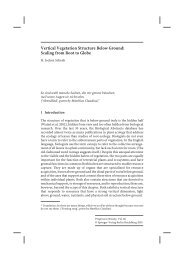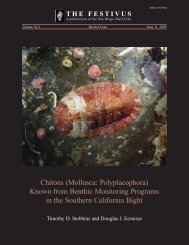LIVE BacLight Bacterial Gram Stain Kit
LIVE BacLight Bacterial Gram Stain Kit
LIVE BacLight Bacterial Gram Stain Kit
Create successful ePaper yourself
Turn your PDF publications into a flip-book with our unique Google optimized e-Paper software.
<strong>Stain</strong>ing <strong>Bacterial</strong> Suspensions<br />
6.1 Mix five different proportions of E. coli and S. aureus<br />
(prepared in step 5.6) in acrylic, glass or quartz fluorescence<br />
cuvettes (1 cm pathlength) (Table 2). The total volume of each of<br />
the five samples will be 3 mL.<br />
6.2 Prepare 1.67 mM SYTO 9 dye, 0.17 mM hexidium iodide<br />
working solution. Mix 25 µL of Component A, 1.8 µL of Component<br />
B and 23 µL DMSO.<br />
6.3 Add 9 µL of 1.67 mM SYTO 9, 0.17 mM hexidium iodide<br />
solution prepared in step 6.2 to each of the five samples (5<br />
samples × 9 µL = 45 µL total) and mix thoroughly by pipetting<br />
up and down several times.<br />
6.4 Incubate at room temperature in the dark for 15 minutes.<br />
Fluorescence Spectroscopy and Data Analysis<br />
7.1 Measure the fluorescence emission spectrum (excitation<br />
470 nm, emission 480–700 nm) of each cell suspension (F cell<br />
) in<br />
a fluorescence spectrophotometer (Figure 1a).<br />
Table 2. Volumes of E. coli and S. aureus bacterial suspensions to mix<br />
to achieve various proportions of the suspensions.<br />
Ratio of E. coli : S. aureus<br />
<strong>Bacterial</strong> Suspensions<br />
7.2 Calculate the ratio of the integrated intensity of the portion of<br />
each spectrum between 490–510 nm (em1; green) to that<br />
between 590–610 (em2; red) for each bacterial suspension.<br />
Ratio<br />
G/R<br />
F<br />
=<br />
F<br />
mL E. coli<br />
Cell Suspension<br />
cell,em1<br />
cell,em2<br />
mL S. aureus<br />
Cell Suspension<br />
0 : 100 0 3.0<br />
10 : 90 0.3 2.7<br />
50 : 50 1.5 1.5<br />
90 : 10 2.7 0.3<br />
100 : 0 3.0 0<br />
7.3 Plot the log 10<br />
of the ratio of integrated green fluorescence to<br />
integrated red fluorescence (Ratio G/R<br />
) versus percentage of E. coli<br />
suspension (Figure 1b).<br />
Fluorescence Microplate Readers<br />
Overview<br />
Conditions required for measurement of fluorescence in microplate<br />
readers are very similar to those required for fluorescence<br />
spectroscopy of bacterial cell suspensions. As in fluorescence<br />
spectroscopy experimental protocols, reagent concentrations are<br />
typically lower than those recommended for fluorescence microscopy,<br />
and the ratio of green to red fluorescence emission is proportional<br />
to the relative amount of fluorescence of the two bacterial<br />
populations even though the absolute cell densities may be very<br />
different.<br />
Culture Conditions and Preparation of <strong>Bacterial</strong> Suspensions<br />
8.1 Grow 30 mL cultures of E. coli and S. aureus to log phase in<br />
nutrient broth (e.g., DIFCO catalog # 0003-01-6).<br />
8.2 Concentrate 25 mL of each bacterial culture (separately)<br />
by centrifugation at 10,000 × g for 10–15 minutes.<br />
8.3 Remove the supernatants and resuspend the pellets from<br />
each bacterial culture in 2 mL of filter-sterilized water (filtered<br />
through a 0.2 µm pore–size filter to remove particulate matter).<br />
Figure 1. Analysis of the proportion of E. coli in suspension by fluorescence<br />
spectroscopy. a) Emission spectra of suspensions of various<br />
proportions of E. coli and S. aureus suspensions were obtained from<br />
samples prepared and stained as outlined in section 5.2–5.3. Integrated<br />
fluorescence emission intensities (see Figure 1b) were determined<br />
from the spectral regions indicated by dashed vertical lines. b) Integrated<br />
intensities of the green (490–510 nm) and red (590–610 nm)<br />
emission were acquired and the green/red fluorescence ratios (Ratio G/R<br />
)<br />
were calculated for each proportion of E. coli suspension according to<br />
the equation in 7.2. The line is a least-squares fit of the relationship<br />
between % gram-negative bacteria (E. coli, x) and log 10<br />
Ratio G/R<br />
(y).<br />
8.4 Dilute each concentrated bacterial suspension to a final<br />
volume of 20 mL with filter-sterilized water.<br />
8.5 Determine the optical density at 670 nm (OD 670<br />
) of a 3 mL<br />
aliquot of each bacterial suspension in an absorption cuvette<br />
(1 cm pathlength).<br />
8.6 Adjust the E. coli suspension to 1 × 10 8 bacteria/mL<br />
(~0.030 OD 670<br />
) and the S. aureus suspension to 5 × 10 6 bacteria/mL<br />
(~0.074 OD 670<br />
). S. aureus suspensions typically should be<br />
20-fold less concentrated than E. coli in these experiments.<br />
4<br />
<strong>LIVE</strong> <strong>BacLight</strong> <strong>Bacterial</strong> <strong>Gram</strong> <strong>Stain</strong> <strong>Kit</strong>s
















